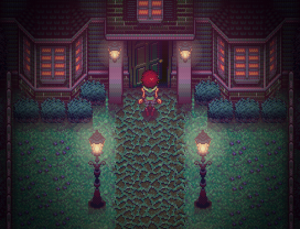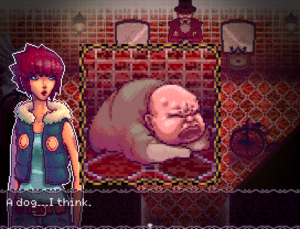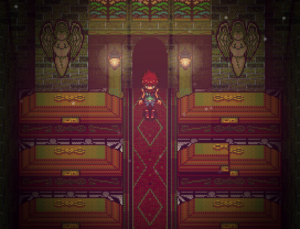Official Site || Steam Page || RPGMaker.net Page
Stray Cat Crossing is a strange game and a very difficult one to write about while avoiding spoilers. It initially presents itself as a horror game, but this gradually changes after the first of this game’s three acts. Instead, this is a disturbing and mysterious adventure through a place where nothing is as it first seems.
To get this out of the way at the start, Stray Cat Crossing does not revolve around challenging gameplay or complicated puzzles. The game is effecting broken up into three parts and, to the best of my knowledge, there are only two points at which you can get a Game Over, both of which occur in the first third. Puzzles exist, but there never become more complicated than figuring out a password or bringing the right items to certain NPC’s. The overall lack of challenge is for the best though as the focus is very clearly on the storytelling and the atmosphere, both of which would suffer if a player got stuck somewhere due to a tough boss or an incomprehensible puzzle.
 The initial premise for this game is simple enough, but things soon spin into unexpected territory. Our nameless protagonist is crossing the street on her way back home at night when she notices a lone little girl. The girl’s name turns out to be Cat and the protagonist offers to walk her back to her home, giving her a scarf along the way because the girl says that she is cold. They arrive at the girl’s house without much incident and the girl thanks the protagonist and then goes into her house, taking the protagonist’s scarf with her. As this scarf is very important to the protagonist for unknown reasons, she follows the girl and, finding the front door unlocked, enters the house. Naturally, there is something very unnatural about this house with a television displaying only static, a blind boy with a camera who will take a picture to save your game, a masked man rapidly twitching his head blocking the way upstairs, and a series of footprints leading into the basement. From here, you gradually explore the house as you discover the secrets about Cat and her family.
The initial premise for this game is simple enough, but things soon spin into unexpected territory. Our nameless protagonist is crossing the street on her way back home at night when she notices a lone little girl. The girl’s name turns out to be Cat and the protagonist offers to walk her back to her home, giving her a scarf along the way because the girl says that she is cold. They arrive at the girl’s house without much incident and the girl thanks the protagonist and then goes into her house, taking the protagonist’s scarf with her. As this scarf is very important to the protagonist for unknown reasons, she follows the girl and, finding the front door unlocked, enters the house. Naturally, there is something very unnatural about this house with a television displaying only static, a blind boy with a camera who will take a picture to save your game, a masked man rapidly twitching his head blocking the way upstairs, and a series of footprints leading into the basement. From here, you gradually explore the house as you discover the secrets about Cat and her family.
 Though this is not entirely a horror game, there is a constantly unsettling atmosphere throughout which is largely created and maintained by the excellent aesthetics. The environment is highly interactive and you get flavor text from examining virtually everything from the kitchen stove to individual lights on the walls; the bookshelves are particularly noteworthy as each section makes a reference to a different poet, essay, or book, all of which relate in some way to the events of the game. There is plenty of color variety, but the palette as a whole is very subdued and deliberately unpleasant with many of the places and characters looking washed out, pale, or worn. Every section of the house has a very distinct appearance as well; the ‘hub’ part of the house may seem relatively normal, but the basement is filled with old-fashioned bicycles, old streetlamps, and other objects from the early 1900’s which make no sense in a basement. Character designs further help to cement the sense of strange unease pervading the house and the cast includes a giant talking nutcracker, a boy with a ram’s skull for a face, caterpillars with a woman’s face, and a rather literal wolf spider. The one area in which the graphics fall a bit short is in the cutscene department; the basement is filled with small clips of animation, some of which serve as the closest this game ever gets to having jumpscares, but there are almost none in the second area and no clips at all for the finale. It’s a bit disappointing as the animation quality is great and it’s strange that the game is so heavily frontloaded with these, but the spritework is still good enough to do justice to the plot.
Though this is not entirely a horror game, there is a constantly unsettling atmosphere throughout which is largely created and maintained by the excellent aesthetics. The environment is highly interactive and you get flavor text from examining virtually everything from the kitchen stove to individual lights on the walls; the bookshelves are particularly noteworthy as each section makes a reference to a different poet, essay, or book, all of which relate in some way to the events of the game. There is plenty of color variety, but the palette as a whole is very subdued and deliberately unpleasant with many of the places and characters looking washed out, pale, or worn. Every section of the house has a very distinct appearance as well; the ‘hub’ part of the house may seem relatively normal, but the basement is filled with old-fashioned bicycles, old streetlamps, and other objects from the early 1900’s which make no sense in a basement. Character designs further help to cement the sense of strange unease pervading the house and the cast includes a giant talking nutcracker, a boy with a ram’s skull for a face, caterpillars with a woman’s face, and a rather literal wolf spider. The one area in which the graphics fall a bit short is in the cutscene department; the basement is filled with small clips of animation, some of which serve as the closest this game ever gets to having jumpscares, but there are almost none in the second area and no clips at all for the finale. It’s a bit disappointing as the animation quality is great and it’s strange that the game is so heavily frontloaded with these, but the spritework is still good enough to do justice to the plot.
The soundtrack may even trump the graphics when it comes to building the atmosphere. Nearly every track in the game from the moment you first lay eyes on the unfocused title screen to the ending credits is deliberately discordant and often filled with sharp, jarring spikes of sound or notes which linger just a little too long to be comfortable. Even the few songs which are more pleasant in nature, such as the theme which plays while in the hub of the house, carry an underlying sense of melancholy or menace. For a game which takes less than two hours to finish, there is an undeniably impressive amount of work put into creating an extensive and memorable soundtrack.
 The most effective part of Stray Cat Crossing is its refusal to explain the details of its narrative. Don’t worry about this being a game which wraps things up with a cheap twist, it provides plenty of foreshadowing every step of the way, and you also have no need to worry about this game getting so wrapped up in its own symbolism and mysteries that it makes no sense at all as the point upon which the game revolves becomes spelled out as vividly as possible. This is the video game equivalent of a story told by an unreliable narrator. Past events play an important role in the story, but exactly how those events played out, the actual order in which they took place, or even if some of them really took place at all are left up to the player’s interpretation. The extensive amount of flavor text found throughout the game isn’t just for show either as just about everything in the house, including the house itself, is symbolic, metaphorical, or otherwise referential in nature. This deliberate vagueness applies to the characters themselves as the way they interact with the protagonist and the roles they play change over time and in some cases multiple characters can represent a single figure or character archetype. You’ll have plenty of answers by the end of this short tragedy, but you can fully expect to be left with even more questions.
The most effective part of Stray Cat Crossing is its refusal to explain the details of its narrative. Don’t worry about this being a game which wraps things up with a cheap twist, it provides plenty of foreshadowing every step of the way, and you also have no need to worry about this game getting so wrapped up in its own symbolism and mysteries that it makes no sense at all as the point upon which the game revolves becomes spelled out as vividly as possible. This is the video game equivalent of a story told by an unreliable narrator. Past events play an important role in the story, but exactly how those events played out, the actual order in which they took place, or even if some of them really took place at all are left up to the player’s interpretation. The extensive amount of flavor text found throughout the game isn’t just for show either as just about everything in the house, including the house itself, is symbolic, metaphorical, or otherwise referential in nature. This deliberate vagueness applies to the characters themselves as the way they interact with the protagonist and the roles they play change over time and in some cases multiple characters can represent a single figure or character archetype. You’ll have plenty of answers by the end of this short tragedy, but you can fully expect to be left with even more questions.
Stray Cat Crossing is far closer to Silent Hill than Resident Evil. It excels at creating a disturbing atmosphere and building up a mystery and avoids gore and cheesy dialogue. This is not so much a horror story as it is a tragedy told in three acts and it is definitely worth the price of admission.